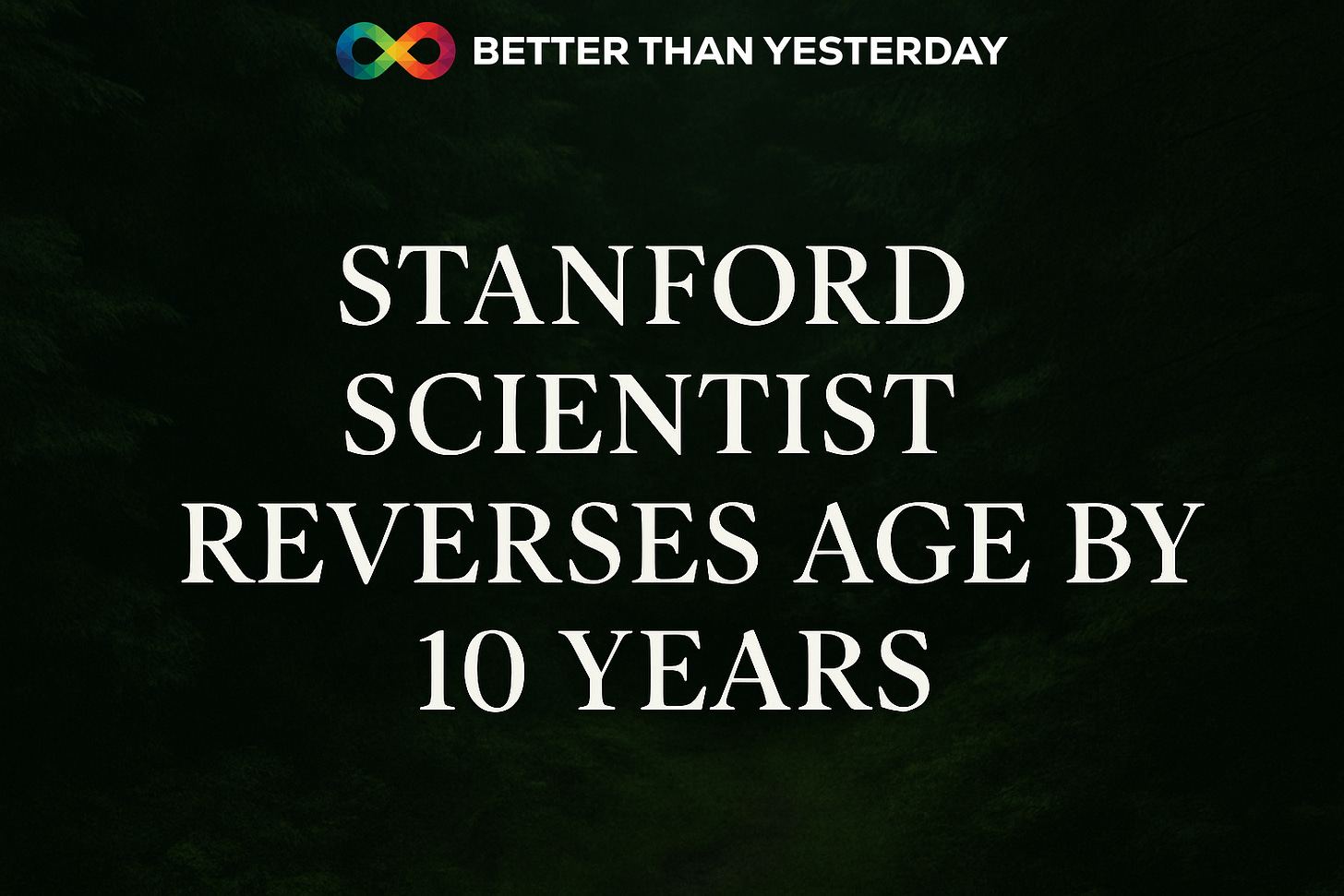Stanford Scientist Reversed His Age by 10 Years with a Simple Nature-Based Lifestyle
Why ditching screens and embracing the outdoors may be the ultimate science-backed longevity hack

I’ve read a lot of wild biohacking experiments. But this one hit different.
A Stanford scientist—chronologically 39 years old—found out his inflammatory age was actually 42. That’s the kind of age gap you don’t want. So he did something few in Silicon Valley would dare: he quit the noise, moved to a forest cabin, and reset his entire life.
Three years later, his inflammatory age wasn’t 42 anymore. It was 32.
Yep—this guy reversed his biological age by a decade. No drugs. No tracking wearables. Just nature, simplicity, and consistency.
Let’s break it down.
What’s an “inflammatory age,” and why does it matter?
Dr. David Furman, a longevity researcher at Stanford and co-founder of the 1000 Immunomes Project, decided to test his inflammatory markers—the kind of cellular signals linked to chronic disease and accelerated aging.
Despite being just 39, the test said he had the inflammation levels of a 42-year-old. And he was feeling it: migraines, fatigue, and the kind of brain fog that makes you rethink your life choices.
Inflammation is one of the biggest silent killers in modern aging. It's tied to heart disease, diabetes, cognitive decline, and even depression. If your inflammatory age is higher than your chronological one, your internal systems are under stress—and aging faster.
That was Furman’s wake-up call.
The Radical Reset: A forest cabin and full digital detox
Furman didn’t just take a sabbatical. He flipped his whole lifestyle upside down.
He packed up his life, wife, and kids, and moved to a tiny two-bedroom cabin in Northern California’s wilderness.
There were no chairs. No artificial lights after 7:30pm. No smartphones, no screens, no Netflix. Just candlelight, analog living, and food from the land.
Here’s what daily life looked like:
10–15 pull-ups to start the day
Fishing fresh trout from the creek
Eating berries, wild greens, organic produce
Zero screens after sunset
Complete break from the urban stress cycle
This was part self-experiment, part family retreat, and part scientific field study.
And it worked.
The results: inflammation reversed, productivity skyrocketed
After three years, Furman re-ran the same cellular tests. This time, his inflammatory age dropped to 32.
Not only did the migraines disappear, but he reported better focus, more energy, and what he called “a surge in productivity.” He published three scientific papers that year alone.
He didn’t just feel better—his biomarkers backed it up.
What does science say about nature and health?
This isn’t just one guy’s success story. There’s mounting research that nature exposure works wonders for your health—even in short doses.
A 2019 study led by Dr. Mathew White at the University of Exeter found that just two hours a week in nature (whether split up or all at once) was the sweet spot for improving overall health and wellbeing.
Not 60 minutes. Not 90. Two full hours.
And it didn’t need to be deep in the woods—urban parks and local beaches worked just as well. What mattered most was immersion and consistency.
This study, published in Scientific Reports, included nearly 20,000 participants and is one of the largest of its kind. It concluded that those who spent 120 minutes or more per week in nature were significantly more likely to report good health and high well-being.
✅ Better sleep
✅ Lower stress
✅ Enhanced immune function
✅ Improved cognition
✅ Reduced anxiety and depression
All from a simple walk in the park.
Why is nature so powerful?
Several reasons.
Stress downregulation: Natural environments activate the parasympathetic nervous system, promoting calm and reducing cortisol levels.
Visual and sensory reset: Nature provides a full-spectrum light experience, which resets circadian rhythms and supports melatonin production.
Movement without strain: Walking, foraging, or swimming in natural settings encourages low-intensity, functional movement that supports joint health, mitochondrial function, and brain plasticity.
Digital dopamine detox: The absence of screen-induced dopamine spikes gives your brain a chance to rebalance, improving focus and emotional regulation.
Microbiome enrichment: Contact with soil, plants, and fresh air introduces healthy microbes that can support immune function and gut diversity.
And unlike supplements or high-tech devices, this is free and instantly accessible.
“I can’t move to the woods. Now what?”
You don’t have to. That’s the beauty of the science.
Here’s how you can apply the Furman Protocol—without uprooting your life:
Block 2 hours a week for intentional time in nature (parks count).
Turn off screens after sunset 1–2 nights per week.
Swap indoor lighting for warm, low-lux sources (candles, salt lamps).
Walk barefoot on grass or sand for grounding benefits.
Eat more wild or organic foods—especially leafy greens and berries.
Create a nature routine you repeat weekly. Habit = results.
Bonus: consider “digital sabbath” days where you disconnect from tech and immerse yourself in natural sounds, sights, and smells.
The bottom line
We’ve been sold the idea that high performance comes from more tech, more data, and more stimulation.
But the real flex? Knowing when to simplify.
Dr. Furman’s journey proves that longevity isn’t always found in a pill bottle or a lab—it might be waiting in the trees outside your city.
If you’re feeling burnt out, inflamed, or mentally foggy… don’t just grind harder. Touch grass. Watch the sun set. Ditch the dopamine drip.
Nature heals. And now we have the science to prove it.
🧬 Enjoy posts like this? Share with a friend and subscribe for more science-backed longevity tips from Better Than Yesterday.
🧠 Simple. Tactical. Backed by research.

